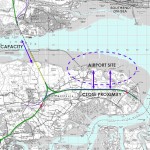Executive summary of Metrotidal and Thames Reach Airport proposals – October 2012
INTRODUCTION
Metrotidal Tunnel and Thames Reach Airport are independent private sector initiatives, the first a solution to providing a new Lower Thames Tunnel, the second a phased new hub airport in the Thames Estuary. While the initiatives are independent they can be fully co-ordinated, with the tunnel providing surface access for a hub airport developed in phases.
Metrotidal Tunnel integrates a multi-modal Lower Thames Tunnel with new flood defences for London, tidal power and data storage. The integrated tunnel infrastructure provides economic growth without an associated increase in carbon audit. This green-growth is achieved through improved transport connectivity, with emphasis on rail, integrated with a flood defence system and tidal power plant that generates and stores renewable energy for supply on demand. The tidal plant includes energy-efficient data storage and distribution. These green-growth agglomeration benefits extend beyond the Thames Estuary region across London and the Greater Southeast.
Thames Reach Airport is the phased construction of a new, 24-hour, hub airport on the Isle of Grain purpose-designed to be time and energy efficient, providing the shortest times for transfer and transit and the lowest carbon audit per passenger, air-side, land-side and for the surface access. This enables the new airport to command the greatest pool of passenger demand and offer the widest range of destinations of any hub in Europe.
The separate tunnel and airport agendas enable policy makers, planners, promoters, investors, stakeholders and regulators to distinguish their separate benefits, impacts and costs. Metrotidal Tunnel provides substantial green-growth agglomeration benefits for the Thames Estuary Region and is viable without an airport while also providing sufficient capacity for the airport surface access. Thames Reach Airport makes use of Metrotidal Tunnel, thereby reducing the start-up costs for the first 24-hour runway and associated hub facilities. The low start-up costs and environmental impacts of the separate tunnel and airport developments enable them to be funded by the private sector.
The Thames, the tunnel and the airport create a caduceus of connections between East and West, heralding a new wave of trade, inward investment and green-growth for Britain in the 21st century.
METROTIDAL TUNNEL BENEFITS
- high agglomeration and connectivity benefits across the Greater Southeast
- the integration of flood defence, tidal power and data storage agendas to reduce their cost and increase net economic benefits
- economic growth with a lower carbon audit, i.e. green-growth
- new flood defences in the event of a surge tide
- the generation of tidal power
- the storage and distribution of renewable energy
- energy-efficient, data storage and distribution
- new utility connections across the estuary including fresh water supplies
- ancillary development in Essex and Kent
- relief of congestion at the Dartford Crossing
- the resilience of alternative connections across the Thames Estuary
- new inner-orbital rail and road networks serving the Thames Estuary region
- new outer-orbital rail networks for the northeast and southeast quadrants of London
- new rail services for Stansted and Gatwick Airports
- European GC-gauge freight connections for Essex, East Anglia and the Midlands
THAMES REACH AIRPORT BENEFITS
- 24-hour operation
- purpose-designed, new-build hub airport
- the most energy and time efficient new capacity
- the largest European hub serving the largest pool of passenger demand
- the best comparative proximity to the pool of passenger demand
- use of renewables including tidal and wind power
- new employment for areas of chronic high unemployment
- close to existing aviation fuel supply depots and distribution
- minimum impact on habitat and heritage for an on-shore solution
TUNNEL AND AIRPORT INTEGRATION BENEFITS
- the integration of agglomeration and aviation benefits for the Greater Southeast
- the ability of policy makers, planners, promoters, investors, stakeholders and regulators to distinguish and direct the separate opportunities, impacts, benefits and
costs of the tunnel and airport agendas - the phased construction of new airport capacity
- the cost savings and resilience of maintaining Heathrow during the phased construction
- the lowest aviation start-up cost, lowest overall cost and lowest environmental impact per passenger
- the largest pool of passenger demand with the highest percentage of rail surface access for passengers and employees
- direct rail services between the new hub, Stansted and Gatwick Airports
- the highest air-rail substitution
- the use and proximity of existing settlements to generate the airport employment
- the reduction of bird strike risk on the approaches to the runways, by the sea from the east and tidal pools from the west
- renewable energy to reduce the carbon audit of the airport construction and operation
- higher connectivity, trade and inward investment for the UK




